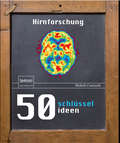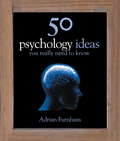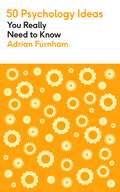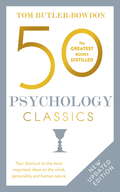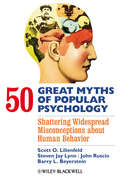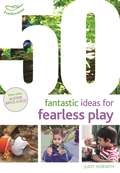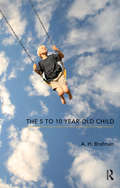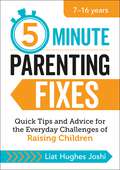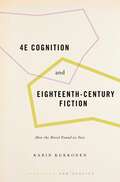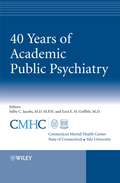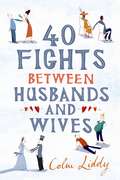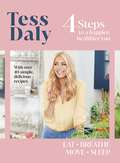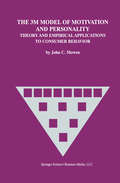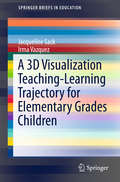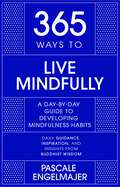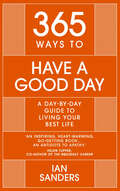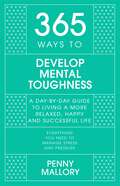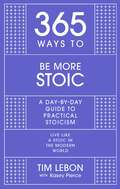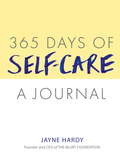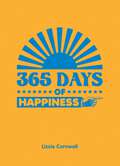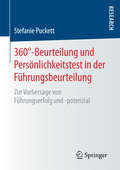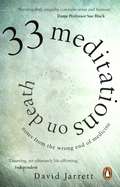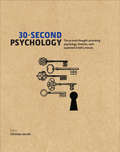- Table View
- List View
50 Schlüsselideen Hirnforschung
by Moheb CostandiEine Entdeckungsreise in die Welt der Nervenzellen und Synapsen, der Gedanken und GefühleDas Nervensystem Die Neuronenlehre Gliazellen Der Nervenimpuls Synaptische Übertragung Sensorische Wahrnehmung Bewegung Topografische Kartierung Spezialisierte Hirnregionen Asymmetrie des Gehirns Spiegelneurone Das Konnektom Verkörperte Kognition Körperbewusstsein Der freie Wille Geschlechtsunterschiede Persönlichkeit Hirngeschädigte Patienten Das Theater des Bewusstseins Bewusstseinsstörungen Aufmerksamkeit Arbeitsgedächtnis Lernen und Gedächtnis Mentale ZeitreisenGedächtnis(re)konsolidierung Entscheidungsfindung Belohnung und Motivation Sprachverarbeitung Exekutive Funktionen Zellwanderung und axonale Wegfindung Zelltod Synaptisches Pruning Neuroplastizität Adoleszenz Stress und Gehirn Das alternde Gehirn Neurodegeneration Adulte Neurogenese Epigenetik Default Mode Network Hirnwellenoszillationen Vorhersagefehler Neuronale Stammzellen Hirnstimulation Kognitive Verstärkung Hirnscan-Verfahren Gedanken entschlüsseln Hirn-Computer-Schnittstellen Neurowissenschaften und das Gesetz Neuroethik _____ Mit seinen unglaublichen 100 Milliarden Nervenzellen, die Informationen in Sekundenbruchteilen weiterleiten, ist das menschliche Gehirn das einflussreichste und zugleich rätselhafteste unserer Organe. Zwar wird es schon seit Jahrzehnten erforscht und experimentell untersucht, doch erst vor relativ kurzer Zeit gewann man Erkenntnisse über seine komplexen inneren Abläufe und darüber, wie es unsere Gedanken, Handlungen und Erinnerungen, ja sogar unsere Selbstwahrnehmung steuert.Auf seiner faszinierenden Erkundungsreise durch das Gehirn widmet sich der Neurobiologe Moheb Costandi sowohl dessen biologischen Funktionen als auch seinem Einfluss auf unser Verhalten. In 50 kompakten, verständlich geschriebenen Kapiteln berichtet er von spannenden neuen Erkenntnissen auf dem Gebiet der Neurowissenschaften. Sind männliche und weibliche Gehirne wirklich unterschiedlich? Haben Emotionen eine biologische Grundlage? Werden wir jemals Gedanken lesen können? Und können die Erfahrungen, die wir machen, unser Gehirn physisch verändern? Von der Entwicklung des Gehirns während des Wachstums und im Alter bis zu den Bausteinen des Bewusstseins, von Geisteskrankheiten wie Demenz und Schizophrenie bis zu der Frage, wie sich Nervengewebe in Reaktion auf Traumata anpassen und neu konfigurieren kann – dieses Buch bietet eine umfassende Einführung in die aufregende Wissenschaft vom menschlichen Gehirn.
50 Psychology Ideas You Really Need to Know (50 Ideas You Really Need to Know series)
by Adrian FurnhamHow different are men and women's brains? Does altruism really exist? Are our minds blank slates at birth? And do dreams reveal our unconscious desires? Psychology is everywhere in today's society. No crime fiction, documentary, chat show or medical consultation is complete without the introduction of a psychological angle. Psychology seeks to understand and explain thoughts, feelings and behaviour through a dizzying array of ideas and theories, shedding light on everything from memory, social mobility and attitude formation to delusions of grandeur, alcoholism and computer phobia, to name a few. In 50 Psychology Ideas You Really Need to Know, Professor Adrian Furnham explains the central ideas of psychology in 50 concise and accessible essays. Packed with the latest research, most important case studies and arguments of key thinkers, this book is the perfect introduction to psychological theory. Contents include: Placebo effect; Kicking the habit; Hallucinations; Positive psychology; Emotional intelligence; IQ and you; Multiple intelligences; The Rorschach inkblot test; Detecting lies; Obedience to authority; Self-sacrifice or selfishness; Gambler's fallacy; Remembrance of things past; Artificial intelligence; Tip-of-the-tongue phenomenon; Psychosexual stages; Tabula rasa; Phrenology; Dyslexia.
50 Psychology Ideas You Really Need to Know (50 Ideas You Really Need to Know series)
by Adrian FurnhamIn a series of 50 accessible essays, Adrian Furnham introduces and explains key theories around clinical and developmental psychology, behaviourism, society and personality, cognitive psychology and individual differences.From understanding emotions to detecting perception, Freud's psychosexual stages to the placebo effect, 50 Psychology Ideas You Really Need to Know is a complete introduction to the most important psychological concepts in history.
50 Psychology Classics: Who We Are, How We Think, What We Do (50 Classics Ser.)
by Tom Butler-BowdonIn a journey spanning 50 books, hundreds of ideas and over a century, 50 Psychology Classics looks at some of the most intriguing questions relating to the human mind.This brand new edition covers the great thinkers of psychology right up to the present day, from iconic psychologists such as Freud, Piaget, and Pavlov to contemporary classic texts like Thinking, Fast and Slow; Quiet and The Marshmallow Test. 50 Psychology Classics examines what motivates us, what makes us feel and act in certain ways, how our brains work, and how we create a sense of self. This is the perfect introduction to some of psychology's greatest minds and their landmark books.
50 Great Myths of Popular Psychology: Shattering Widespread Misconceptions about Human Behavior (Great Myths of Psychology)
by Scott O. Lilienfeld Steven Jay Lynn John Ruscio Barry L. Beyerstein50 Great Myths of Popular Psychology uses popular myths as a vehicle for helping students and laypersons to distinguish science from pseudoscience. Uses common myths as a vehicle for exploring how to distinguish factual from fictional claims in popular psychology Explores topics that readers will relate to, but often misunderstand, such as 'opposites attract', 'people use only 10% of their brains', and 'handwriting reveals your personality' Provides a 'mythbusting kit' for evaluating folk psychology claims in everyday life Teaches essential critical thinking skills through detailed discussions of each myth Includes over 200 additional psychological myths for readers to exploreContains an Appendix of useful Web Sites for examining psychological myths Features a postscript of remarkable psychological findings that sound like myths but that are true Engaging and accessible writing style that appeals to students and lay readers alike
50 Great Myths of Popular Psychology: Shattering Widespread Misconceptions about Human Behavior (Great Myths of Psychology)
by Scott O. Lilienfeld Steven Jay Lynn John Ruscio Barry L. Beyerstein50 Great Myths of Popular Psychology uses popular myths as a vehicle for helping students and laypersons to distinguish science from pseudoscience. Uses common myths as a vehicle for exploring how to distinguish factual from fictional claims in popular psychology Explores topics that readers will relate to, but often misunderstand, such as 'opposites attract', 'people use only 10% of their brains', and 'handwriting reveals your personality' Provides a 'mythbusting kit' for evaluating folk psychology claims in everyday life Teaches essential critical thinking skills through detailed discussions of each myth Includes over 200 additional psychological myths for readers to exploreContains an Appendix of useful Web Sites for examining psychological myths Features a postscript of remarkable psychological findings that sound like myths but that are true Engaging and accessible writing style that appeals to students and lay readers alike
50 Fantastic Ideas for Fearless Play (50 Fantastic Ideas)
by Judit Horvath Alistair Bryce-CleggFearless play is a key element in developing a child's confidence, extending their limits, and helping them learn to assess risks and manage situations. This new edition to the 50 Fantastic series is full of fun and colourful ideas for facilitating fearless play in early years settings. The variety of activities means there's something for every child to enjoy, ranging from basket making to mud racing. Each idea is targeted to help children face new challenges and explore the world around them, as well as helping to establish motor skills, coordination, and body awareness. A perfect resource for busy early years practitioners who want children in their care to play safely and fearlessly.
The 5 to 10 Year-Old Child (The Karnac Developmental Psychology Series)
by A.H. BrafmanThe fifth birthday represents an important landmark in a child's development. He is now ready to start full-time primary school, and we no longer speak of a baby or a little child; instead, we refer to the boy or the girl. Over the next five years, as his horizons become wider and his experiences outside the home increase exponentially, he seems to become more reserved; more difficult to approach and share things with. Sometimes, ordinary questions are ignored or responded to with some apparently unrelated answer. Occasionally, the child will move away even while someone is speaking to him. This is a child trying to make sense of his new experiences, adapting to new people and places, while preserving his link to his earlier environment. Adults can feel frustrated by this behaviour and impatient, but when moved to protest, tend to use words of exasperation rather than plain anger.
The 5 to 10 Year-Old Child (The Karnac Developmental Psychology Series)
by A.H. BrafmanThe fifth birthday represents an important landmark in a child's development. He is now ready to start full-time primary school, and we no longer speak of a baby or a little child; instead, we refer to the boy or the girl. Over the next five years, as his horizons become wider and his experiences outside the home increase exponentially, he seems to become more reserved; more difficult to approach and share things with. Sometimes, ordinary questions are ignored or responded to with some apparently unrelated answer. Occasionally, the child will move away even while someone is speaking to him. This is a child trying to make sense of his new experiences, adapting to new people and places, while preserving his link to his earlier environment. Adults can feel frustrated by this behaviour and impatient, but when moved to protest, tend to use words of exasperation rather than plain anger.
5-Minute Parenting Fixes: Quick Tips and Advice for the Everyday Challenges of Raising Children
by Liat Hughes JoshiThis book is for time-poor parents who need reliable, tried and tested advice for all your parenting conundrums, from how to resolve online bullying to getting your child to do their homework. These no-nonsense solutions, each designed to be read in less than 5 minutes, will help boost your confidence when making important parenting decisions.
4E Cognition and Eighteenth-Century Fiction: How the Novel Found its Feet (Cognition and Poetics)
by Karin KukkonenWhen the novel broke into cultural prominence in the eighteenth century, it became notorious for the gripping, immersive style of its narratives. In this book, Karin Kukkonen explores this phenomenon through the embodied style in Eliza Haywood's flamboyant amatory fiction, Charlotte Lennox's work as a cultural broker between Britain and France, Sarah Fielding's experimental novels, and Frances Burney's practice of life-writing and fiction-writing. Four female authors who are often written out of the history of the genre are here foregrounded in a critical account that emphasizes the importance of engaging readers' minds and bodies, and which invites us to revisit our understanding of the rise of the modern novel. Kukkonen's innovative theoretical approach is based on the approach of 4E cognition, which views thinking as profoundly embodied and embedded in social and material contexts, extending into technologies and material devices (such as a pen), and enactive in the inherent links between perceiving the world and moving around in it. 4E Cognition and Eighteenth-Century Fiction investigates the eighteenth-century novel through each of these trajectories and shows how language explores its embodied dimension by increasing the descriptions of inner perception, or the bodily gestures around spoken dialogue. The embodied dimension is then related to the media ecologies of letter-writing, book learning, and theatricality. As the novel feeds off and into these social and material contexts, it comes into its own as a lifeworld technology that might not answer to standards of nineteenth-century realism but that feels 'real' because it is integrated into the lifeworld and embodied experiences. 4E cognition answers one of the central challenges to cognitive literary studies: how to integrate historical and cultural contexts into cognitive approaches.
40 Years of Academic Public Psychiatry
by Selby Jacobs Ezra GriffithsDescribes an outstanding training programme in public psychiatry developed by the Connecticut Mental Health Center A worthwhile and valuable contribution to the field that has no current equivalent in the market The book suggests a plan for the future of public sector psychiatry and serves as a model to centers throughout North America and further afield Describes the impact of the Connecticut Mental Health Center on psychiatric service models in the public sector
40 Fights Between Husbands and Wives: 40 Fights Between Husbands And Wives
by Colm LiddyCouples.Couples at war.Couples apparently at peace - with war simmering beneath the surface.Desire frustrated.Desire, satisfied - but in surprising ways.Revenge at its most creative.Reconciliation at its most tender.Love. Perhaps.Here is the story of how couples are forever tripped up by the missteps of love and sex.This delightfully puckish and highly original work gets under the skin of relationships through the ages - showing the infinity of ways men and women drive each other crazy, yet remain essential to one another.
4 Steps: To a Happier, Healthier You. The inspirational food and fitness guide from TV's Tess Daly
by Tess DalyWith over 40 delicious, healthy recipes alongside simple stretches, exercises and wellbeing tips, 4 Steps shows that you don't need lots of time or money to make every day that little bit healthier and a lot more fabulous. 'These are the small changes that make a big difference when it comes to putting your wellbeing first.' For the very first time, model, presenter and mum of two Tess Daly shares her take on simple ways to look and feel amazing, whether you're 17 or 70.Eat: Gut-friendly advice and 40 easy family-friendly recipesBreathe: Expert practices to unlock the healing power of breathMove: Exercises and stretches to help you stay energised and flexibleSleep: Ways to help you get that vital rest to recharge you, ready for each dayWith accessible lifestyle hacks and expert advice, alongside simple recipes that are both healthy and delicious, this book is your one-stop shop for better wellbeing every day.
The 3M Model of Motivation and Personality: Theory and Empirical Applications to Consumer Behavior
by John C. MowenIntegrating control theory, evolutionary psychology, and a hierarchical approach to personality, this book presents a new approach to motivation, personality, and consumer behavior. Called the 3M, which stands for `Meta-theoretic Model of Motivation', this theory seeks to account for how personality traits interact with the situation to influence consumer attitudes and actions. The book proposes that multiple personality traits combine to form a motivational network that acts to influence behavior. Mowen argues that in order to understand the causes of enduring behavioral tendencies, one must identify the more abstract traits underlying surface behaviors. In constructing the 3M model, the author reports data from fifteen empirical studies employing over 3500 respondents. In this hierarchical model, four types of personality traits are identified: elemental, compound, situational, and surface traits. Eight elemental traits are proposed as forming the underlying dimensions of personality. Consistent with control theory, the research reveals that the elemental traits combine to form compound traits, such as self-efficacy, task orientation, playfulness, and competitiveness. These elemental and compound traits combine with situational influences to cause enduring behavioral tendencies within general situational contexts. Examples of situational traits investigated include impulsive buying, value consciousness, sports interest, and health motivation. In the 3M model the elemental, compound, and situational traits combine to yield surface traits, which are enduring dispositions to act in specific behavioral contexts. Five surface traits are empirically investigated in the book: compulsive buying, sports participation, healthy diet lifestyles, proneness to bargaining, and a tendency to frugality. Across these five studies, the empirical results reveal that the 3M model accounts for over 44% of the variance in the surface trait measures. By presenting a new meta-theory of motivation and personality that is testable, Mowen's 3M model accounts for high levels of variance in consumer behavior. By integrating the work of selected past and current theorists into a comprehensible whole, the 3M model provides coherence in a field currently dominated by conflicting ideas, theories, and approaches. The book provides evidence that by understanding the individual dispositions that underlie consumer behavior, public policy officials and marketing specialists can develop better communication programs to influence and persuade their target audiences. The book shows how to employ the 3M model to segment the marketplace, provide psychographic inventories, position brands, create promotional themes, and develop brand personalities.
A 3D Visualization Teaching-Learning Trajectory for Elementary Grades Children (SpringerBriefs in Education)
by Jacqueline Sack Irma VazquezThis monograph describes the development and use of a 3D visualization teaching-learning trajectory for elementary age learners. Using design research principles, the authors developed this trajectory using the NCTM recommendations and the Spatial Operational Capacity (SOC) theoretical framework to guide lesson development. The SOC framework utilizes actual 3D models, 2D and abstract representations of the actual models, and, a dynamic computer interface, the Geocadabra Construction Box, which integrates these representations dynamically in real time. The work begins with describing the theoretical SOC frameworks that guided the study, the inquiry-based learning focus, the research method used, and informal pre-program interviews with participant children. The next chapter describes introductory activities used to orient the children to the 3D objects that they used throughout the program. The book then focuses on the development of abstract top-view numeric plan representations leading to representations of rectangular prisms, followed by front-side-top view representations. The last chapter shows how numeracy was integrated into the program to support the demanding official mathematics curriculum.
365 Ways to Live Mindfully: A Day-by-day Guide to Mindfulness (365 Series)
by Pascale Engelmajer365 WAYS TO LIVE MINDFULLY introduces simple ways to develop mindfulness habits, such as identifying personal values, developing related goals and setting out to achieve them, through short concepts, ideas, prompts, profiles, practices and exercises, all based on Buddhist thought and practices.The bite-size entries introduce different Buddhist traditions such as mindfulness, compassion, loving-kindness and karma, and profile inspiring past and present figures to guide you towards taking small, impactful steps at your own pace to increase your mindfulness across all aspects of your life and experience noticeable changes that will have a big impact.
365 Ways to Have a Good Day: A Day-by-day Guide to Living Your Best Life (365 Series)
by Ian SandersHOW ARE THE NEXT TWELVE MONTHS LOOKING FOR YOU? PRETTY MUCH THE SAME AS LAST YEAR? OR ARE YOU READY FOR BETTER? 365 WAYS TO HAVE A GOOD DAY is a full year's worth of daily inspiration, tools, habits, actions, and rituals that will help you live your best life. You'll discover surprising insights from psychologists, business leaders, entrepreneurs and designers. You'll explore the benefits of Feierabends and Laughies, have your eyes opened by a dance psychologist, and find out why one senior executive's tattooed fingers help him make the right career choices. You'll learn habit-forming strategies, pick up helpful hacks, and uncover tips for lasting change - all brought to life through real examples and thought-provoking stories that will get you looking at life differently.You'll meet a cast of characters from around the world who know all about creating success, from the founder of a billion-dollar mindfulness company in California to the Hollywood screenwriter who takes up to eight showers a day to fuel his ideas, and from the Harvard Business School professor who discovered more joy at work by wearing red trainers to the man who every Friday for five years set up a table in central NYC to give advice to strangers, including a gang member on the run. 365 WAYS TO HAVE A GOOD DAY focuses on the small stuff you can do every day to make life better. Because when you get the little things right, the big things follow. Things like figuring out where you're going, hitting reset, designing the life you want, breaking through limiting beliefs, and creating success on your own terms. And when you find what works for you, you can do more of it, making you more productive, more fulfilled, and much happier.IT'S TIME TO SEIZE THE DAY. ALL 365 OF THEM.
365 Ways to Develop Mental Toughness: A Day-by-day Guide to Living a Happier and More Successful Life
by Penny Mallory365 Ways to Develop Mental Toughness is a day-by-day guide to building the confidence and resilience you need to get in control of your life, reach your goals and come out on top.Successful people are mentally tough. And you have to be, because achieving success isn't easy. No one can avoid the minefield of setbacks, crisis, tragedy and challenge that is part of being alive. Life throws obstacles in your path daily, but mentally tough people can manage the stress and pressure. They see challenges as opportunities. They persist no matter what. They pick themselves up and go again. They are confident, humble, in control and 100% committed to what they set out to achieve. That may sound as if mentally tough people are special, but they're not. No one is born with mental toughness - you have to develop it by deliberately working on your resilience, determination, emotional control and focus. Here you'll find a new idea every day to help you do it. Practice them regularly and see the difference it makes. Keep applying them and you will be developing your mental toughness every single day.365 Ways to Develop Mental Toughness focuses on the small stuff you can do every day to make life better. Because when you get the little things right, the big things follow. And today is the very best day to start making those positive changes!
365 Ways to be More Stoic: A day-by-day guide to practical stoicism
by Tim LebonHAPPINESS, SERENITY AND FULFIMENT ARE ALL WITHIN YOUR CONTROL365 WAYS TO BE MORE STOIC is a full year's worth of daily inspiration, tools, stories, actions, and rituals that will guide you to a meaningful life, filled with happiness. It is a simple, list-driven, practical guide that will allow you to immediately begin putting Stoic wisdom into practice in your daily life. Each short chapter makes Stoicism fun to read about and easily digestible, presenting ideas in engaging, bite-size chunks.Immerse yourself in stoicism right from the first chapter, through prompts, concepts, challenges, inspiration, quotes, examples, quizzes and case-studies. You'll learn to navigate through the controllable and inevitable. You'll develop constructive ways to handle frustration, adversity and even your own mortality. You'll learn habit-forming strategies, pick up helpful concepts, and uncover tips for lasting change. This fun and engaging manual will help you live like a Stoic in the modern world. 365 WAYS TO BE MORE STOIC focuses on the small stuff you can do every day to live a happier and wiser life. Because when you get the little things right, the big things follow.
365 Days of Self-Care: A Journal
by Jayne HardyIt's one thing to understand how important self-care is, but how many of us actually manage to make the time do it?In 365 Days of Self-Care, CEO and founder of The Blurt Foundation, Jayne Hardy encourages you to take some time each and every day to be mindful, to check-in and prioritise the things that are truly important to you. This ebook edition contains: 365 daily prompts and trackers to note your moods, sleep and more; thoughtful mini-essays to prompt some deeper work; and check-in pages to help you see your progress - everything you need to get started on your self-care journey. Examples of daily prompts include:· Day 1: Boost· Day 52: Appreciate· Day 142: Rebel· Day 209: Thankful· Day 327: CourageWith the flexibility of choosing to start the journal anytime; on any day, in any year, this is the essential companion for bringing more self-care into your life.
365 Days of Happiness (365 Days Of... Ser.)
by Lizzie CornwallHost an air guitar tournament for your friends and family. Cartwheel down the street. Tell nothing but the truth all day. Prepare for a grand adventure, instigate a little mischief and embrace a sunnier outlook with this book of feel-good quotations and quirky ideas that will keep you smiling all year.
360°-Beurteilung und Persönlichkeitstest in der Führungsbeurteilung: Zur Vorhersage von Führungserfolg und -potenzial
by Stefanie PuckettStefanie Puckett untersucht, ob die Prognose von Führungserfolg über eine 360°-Beurteilung durch die Einbeziehung von Persönlichkeitseigenschaften der Führungskraft verbessert werden kann. Die 360°-Beurteilung ermöglicht es, verschiedene Perspektiven aus dem Umfeld der Führungskraft in deren Beurteilung miteinzubeziehen, beschränkt sich jedoch auf verhaltensbasierte Variablen. Die zentrale Frage lautet: Kann Führungsbeurteilung über eine kombinierte Anwendung verhaltens- und eigenschaftsbasierter Variablen optimiert werden?
33 Meditations on Death: Notes from the Wrong End of Medicine
by David Jarrett_________________“Brilliant - a grimly humorous yet humane account of the realities of growing old in the modern age. Everybody over the age of 60 should read it and ponder their probable future.” - Henry MarshWhat is a good death? How would you choose to live your last few months? How do we best care for the rising tide of very elderly? This unusual and important book is a series of reflections on death in all its forms: the science of it, the medicine, the tragedy and the comedy. Dr David Jarrett draws on family stories and case histories from his thirty years of treating the old, demented and frail to try to find his own understanding of the end. And he writes about all the conversations that we, our parents, our children, the medical community, our government and society as a whole should be having.Profound, provocative, strangely funny and astonishingly compelling, it is an impassioned plea that we start talking frankly and openly about death. And it is a call to arms for us to make radical changes to our perspective on ‘the seventh age of man’.
30-Second Psychology: The 50 Most Thought-provoking Psychology Theories, Each Explained in Half a Minute (30-Second)
by Christian JarrettThe key ideas in Psychology explained, with colour illustrations, in half a minute. Pavlov's Dogs, Psychoanalysis, Milgram's Obedience Study, and Beck's Cognitive Therapy? Sure, you know what they all mean. That is, you've certainly heard of them. But do you know enough about these psychology theories to join a dinner party debate or dazzle the bar with your knowledge? 30-Second Psychology takes the top 50 strands of thinking in this fascinating field, and explains them to the general reader in half a minute, using nothing more than two pages, 300 words, and one picture. The inner workings of the human mind will suddenly seem a lot more fun, and along the way we meet many of the luminaries in the field, including William James, Aaron Beck, and (of course) Sigmund Freud. From Behaviorism to Cognitivism, what better way to get a handle on your inner demons?
